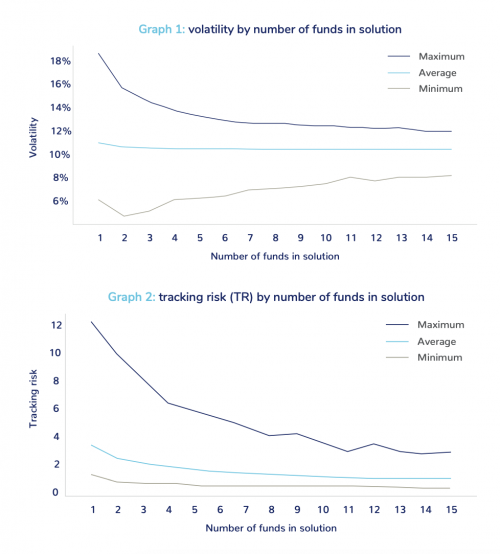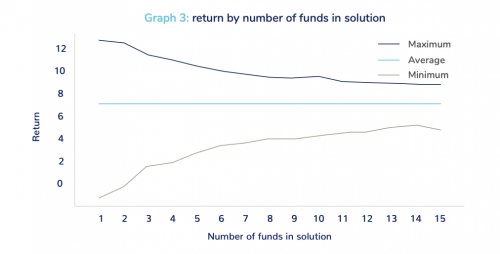INVESTMENT CENTRE
Is There a Right Number of Funds/Managers to Use in a Multi-asset Solution?

Introduction
We are often asked by clients what we think the right number of funds is to use in a multi-managed solution. When using an insufficient amount, adequate diversification might not be achieved as individual fund managers can go through prolonged periods of underperformance. Even the most skillful managers with good track records can underperform for years due to bad luck or their specific investment approach being out of favour. Many clients cannot bear such lengthy underperformance and this often results in disinvestments.
By contrast, when using too many funds the performance may be very close to that of the average performance of the peer group from which funds are picked. Although a safer strategy than putting all your eggs in one basket, most clients probably aim for above average performance.
In this article we present analysis to explain how we go about establishing a suitable number of funds when constructing a typical multi-asset (balanced) solution. The results from the analysis are by no means a “one size fits all” but should help investors understand the interaction in our solutions between the number of funds, diversification, expected returns and practical matters when constructing solutions.
Methodology
We focused on the ASISA SA Multi-Asset High Equity category, the most utilised Collective Investment Schemes (CIS) category of funds in South Africa. In compiling the research, we used a Monte Carlo simulation – a mathematical technique, that is used to estimate the possible outcomes of an uncertain event.
We created 100 000 equally weighted, randomly selected combinations of funds that ranged from combinations of two up to 15 funds in a solution. We then calculated the average volatility and return, as well as the average tracking risk (TR) – previously known as Tracking Error and alpha compared to the benchmark – the ASISA SA Multi-Asset High Equity category.
Diversification results
The diversification results from the simulations are examined from two perspectives – absolute and relative risk – to gather any insights on the right number of funds to use. Let us first look at absolute risk, which we defined as volatility. Volatility is the annualised standard deviation of monthly returns and the higher the volatility, typically the riskier a solution. We view volatility as a suitable proxy for risk given the nature of the underlying assets in the simulations.
The intention of the exercise is to determine if volatility reduces as funds are added to a solution – as presented in Graph 1 over the page. The yellow line is the highest volatility result of each combination of funds, green is the lowest, and blue the average volatility.

The key take-away from the simulated results detailed in Graph 1 is:
The average volatility marginally decreases as you add funds to a solution, while the maximum volatility (worst case scenarios) improves materially. In other words you can reduce your portfolio’s volatility by adding more than one fund. Our ongoing research suggests the inclusion of around six to nine funds or strategies for a typical balanced solution.
As suggested in the introduction, it is difficult to manage investor expectations if peer relative performance is uncompetitive. This is where the next risk measure, TR, is useful, but not perfect. The TR indicates how closely a portfolio follows the performance benchmark used. A TR of 0% suggests the solution and the benchmark performance are identical, which is not appropriate for actively managed solutions as alpha will be zero. A TR above 4% can be considered moderate, with a 32% probability that a solution can out- or underperform the benchmark by more than 4%. For balanced solutions, we consider a TR of between 1% to 2% as appropriate to allow us to achieve above average performance while still managing benchmark risk. We will explain this further below.
Graph 2 shows the simulated average TRs per number of funds used in a solution, and the maximum and minimum values. The key take-aways are:
- On average, a TR of 2% is achieved after including four funds, while a TR of 1% is achieved at around 15 funds – suggesting quite a large range depending on the targeted TR.
- Even with 15 funds, at a TR of 1%, the solution is by no means identical to the peer group average. In other words, a solution does not automatically replicate peers once it holds double digit underlying funds.
- For the maximum TR simulations, note how quickly TR gets diversified when adding funds.
Return expectations – IR is a helpful measure
In this section we tied up the diversification considerations detailed above with the return expectations to establish if there are any insights on the right number of funds to use in a solution. In our opinion, consistent above average performance compared to industry peers is a good outcome for clients that are peer cognisant, while consistent top quartile performance is exceptional.
Our research suggests longer-term alpha of 0.5% would typically place a balanced solution well into the second quartile – our lowest hurdle for our solutions – while alpha of 1% typically places a solution into top quartile. In aiming for this 1% alpha, the information ratio (IR) is a helpful measure. This ratio essentially shows how much alpha was generated, or lost, from the amount of benchmark relative risk taken.
It is a good measure of performance compared to a benchmark and typically a ratio of 0.5 or above is considered as a good result. Therefore, to achieve the desired outperformance compared to the peer group average, a TR of around 1% to 2% is typically required.

Graph 3 illustrates the simulated average return per combination of funds (in absolute terms) over the past five years.

More interestingly Graph 4 illustrates the average alpha relative to the peer group average.
Key take-aways from Graph 4:
- As expected, the average alpha for the simulations is close to zero, which is what investors can expect to achieve on average when selecting funds randomly.
- When looking at the maximum and minimum alpha per combination, note the funnel effect. In our opinion, the typical investor should aim to avoid large underperformance, which gets mitigated as the number of funds increases (blue line).
- The green line presents the alpha required to achieve top quartile performance over the past five years of circa 1%. With good fund choice, it is possible to achieve top quartile performance up to almost 15 funds.
- TR is a double-edged sword. The higher the TR, the bigger the chance of underperformance when underperforming funds are selected. Therefore, adding to the number of funds in a solution will likely mitigate severe underperformance.
Although the historical insights discussed provide good quantitative insights, we also consider practical aspects when constructing solutions.
- Multi-manager role. We spend thousands of hours each year identifying skillful managers, allowing us to generate alpha. We can select from multiple risk type funds/managers or strategies to find our desired outcomes. Our fund line-up is not static but rotates occasionally depending on opportunities. As an example, in our CIS funds, we use segregated account strategies – and not only off-the-shelf funds – to give us further flexibility
- Day-to-day management. The larger the number of funds in a solution, the higher the costs and risks. Each of the underlying funds or strategies needs to be maintained on various accounting and reporting systems, adding to expenses.
- Governance. Regular investment and operation due diligence needs to be performed. Too many funds make this task more onerous.
- Fees. Usually, the more assets you place with any one asset manager, the more favourable the fee negotiations. A balance between negotiating favourable but fair fees and using sufficient underlying funds or strategies to meet objectives, is critical.
Conclusion
Theoretically, investors should include all the relevant funds/managers in a solution that are expected to meet the required return objectives, as risk-adjusted returns should continue to improve as you add more funds – but how many is optimal? The optimal number of funds should be determined by the practical considerations ‘overlay’ to ensure you go beyond the number of funds to also focus on having the right funds/ managers in your solution. Hence, there is not a magical right number of funds or strategies, it is a balancing act between diversification, return potential and an investor’s unique considerations. We currently use between six and nine funds across our multi-asset solutions, which we view as the “sweet spot”. While many investors might be comfortable being invested in a single fund and the associated risks, we prefer a well-constructed multimanaged solution with sufficient diversification, while still allowing good alpha potential.
Key Points:
The right number of funds/managers to include is not an exact science…you need the art.
Building a solution is not all about simplistic simulations – it requires other practical considerations.
Our ongoing research suggests that for a typical balanced solution, the bulk of volatility and tracking risk diversification is achieved through the inclusion of around six to nine funds or strategies.
Knowledge is Power…
Access more insights from the INN8 Invest team’s quarterly report.
For you, the adviser, click below to download a collection of articles to use in your practice.
